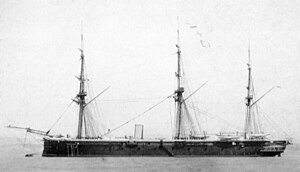Defence-class ironclad
 Defence as she appeared after 1866
| |
| Class overview | |
|---|---|
| Name | Defense-class ironclad |
| Builders | |
| Operators | |
| Preceded by | Warrior class |
| Succeeded by | Hector class |
| Built | 1859–1862 |
| In service | 1861–1935 |
| In commission | 1861–1885 |
| Completed | 2 |
| Scrapped | 2 |
| General characteristics | |
| Type | Armoured frigate |
| Displacement | 6,070–6,150 long tons (6,170–6,250 t) |
| Length |
|
| Beam | 54 ft 2 in (16.5 m) |
| Draught |
|
| Installed power |
|
| Propulsion | 1 shaft; 1 trunk steam engine |
| Sail plan | Barque rigged |
| Speed | 11 knots (20 km/h; 13 mph) |
| Range | 1,670 nmi (3,090 km; 1,920 mi) at 10 knots (19 km/h; 12 mph) |
| Complement | 460 |
| Armament |
|
| Armour | |
The Defence-class ironclads were a
Both ships were initially assigned to the
Background
In 1859 the
The Admiralty's decision saddled the Royal Navy with a pair of ships that could not operate with the Warriors in a tactical
Description
The Defence class was 280 feet (85.3 m)
Propulsion
The Defence-class ships had a single two-cylinder
The ironclads were barque-rigged and had a sail area of 24,500 square feet (2,276 m2).[7] The lower masts and bowsprit were made of iron to withstand the shock of ramming. Both ships could make about 10.5 knots (19.4 km/h; 12.1 mph) under sail alone. To reduce wind resistance while under sail alone, the funnel was semi-retractable. Similarly, the propeller could be hoisted up into the stern of the ship to reduce drag while under sail.[9]
Armament
The armament of the Defence-class ships was intended to be 18
Both ships were rearmed in the late 1860s with 14
The shell of the eight-inch (203 mm) weighed 175 pounds (79.4 kg) while the gun itself weighed 9 long tons (9.1 t). It had a
Armour
The Defence-class ships had a wrought iron armour belt, 4.5 inches (114 mm) thick, that covered 140 feet (42.7 m) amidships. The armour extended from upper deck level to six feet (1.8 m) below the waterline.[19] Transverse bulkheads 4.5 inches thick protected the guns on the main deck from raking fire. The armour was backed by 18 inches (460 mm) of teak. The ends of the ship were left entirely unprotected which meant that the steering gear was very vulnerable. They were, however, sub-divided into many watertight compartments to minimize any flooding.[22]
Ships
| Ship | Builder[4] | Laid down[4]
|
Launched[4] | Commissioned[4] | Fate | Cost |
|---|---|---|---|---|---|---|
| Defence | Palmers, Jarrow | 14 December 1859 | 24 April 1861 | 4 December 1861 | Scrapped, 1935[23] | £252,422[1] |
| Resistance | Westwood, Baillie, Cubitt Town, London | 21 December 1859 | 11 April 1861 | 2 July 1862 | Sold for scrap, 1898, foundered under tow, 4 March 1899,[24] later raised and broken up[7] | £258,120[1] |
Service
HMS Defence was assigned to the Channel Squadron upon completion in 1862. The ship was
HMS Resistance was the first
Notes
- ^ Ironclad is the all-encompassing term for armoured warships of this period. Armoured frigates were basically designed for the same role as traditional wooden frigates, but this later changed as the size and expense of these ships forced them to be used in the line of battle.
- ^ No such gun ever entered RN service during this time; these may have been experimental 70-pounder Armstrong guns developed in parallel with the 40- and 110-pounder guns or the 40-pounder gun called by its calibre, rounding upwards.
Footnotes
- ^ a b c d e Parkes, p. 25
- ^ Brown, p. 14
- ^ a b Silverstone, p. 157
- ^ a b c d e Ballard, p. 241
- ^ Ballard, pp. 164–165, 241
- ^ Ballard, p. 246
- ^ a b c Chesneau & Kolesnik, p. 8
- ^ Ballard, pp. 246–247
- ^ Ballard, pp. 164–166
- ^ a b Parkes, p. 27
- ^ Lambert, p. 108
- ^ Parkes, pp. 27–28
- ^ a b Lambert, p. 103
- ^ Holley, Alexander Lyman (1865). A Treatise on Ordnance and Armor. New York: D Van Nostrand. p. 602.
- ^ "W.L. Clowes on the Anglo-Japanese hostilities of 1863–1864". Retrieved 4 August 2013.
- ^ "The Armstrong Guns in Japan". The Times. 25 April 1864. Archived from the original on 6 March 2012. Retrieved 4 August 2013.
- ^ Owen, Lieutenant-Colonel C. H. (1873). The principles and practice of modern artillery (Second ed.). London: John Murray. p. 52.
- ^ Ballard, p. 165
- ^ a b Parkes, p. 28
- ^ Roberts, p. 6
- ^ Lambert, pp. 108–109
- ^ Ballard, pp. 165, 244
- ^ Silverstone, p. 225
- ^ Silverstone, p. 262
- ^ Ballard, pp. 168–169
- ^ Ballard, pp. 167–168
References
- ISBN 0-87021-924-3.)
{{cite book}}: CS1 maint: multiple names: authors list (link - Brown, David K. (1997). Warrior to Dreadnought: Warship Development 1860–1905. London: Chatham Publishing. ISBN 1-86176-022-1.
- Dodson, Aidan (2015), "The Incredible Hulks: The Fisgard Training Establishment and Its Ships", Warship 2015, London: Conway, pp. 29–43, ISBN 978-1-84486-276-4
- Jones, Colin (1996). "Entente Cordiale, 1865". In McLean, David & ISBN 0-85177-685-X.
- Lambert, Andrew (2010). HMS Warrior 1860: Victoria's Ironclad Deterrent (2nd revised and expanded ed.). Annapolis, Maryland: Naval Institute Press. ISBN 978-1-59114-382-6.
- Parkes, Oscar (1990) [1957]. British Battleships. Annapolis, Maryland: Naval Institute Press. ISBN 1-55750-075-4.
- Silverstone, Paul H. (1984). Directory of the World's Capital Ships. New York: Hippocrene Books. ISBN 0-88254-979-0.
- Winfield, R.; Lyon, D. (2004). The Sail and Steam Navy List: All the Ships of the Royal Navy 1815–1889. London: Chatham Publishing. OCLC 52620555.
